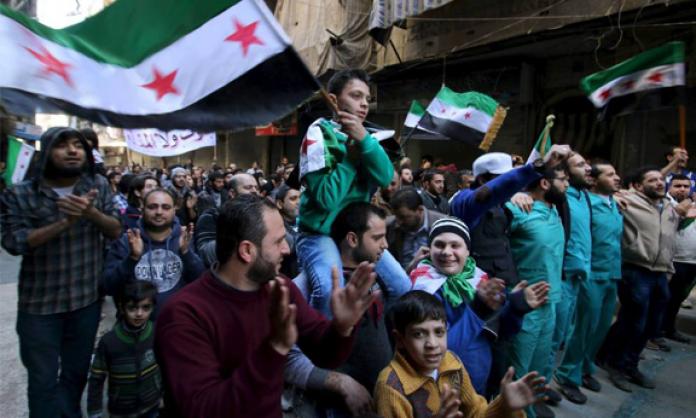Over the last four years, the Syrian people have paid a horrendous price for having the audacity to rise up against dictatorship and demand their freedom. Liberated cities have been reduced to rubble, pulverised by relentless waves of barrel bombs, chemical weapons, and most recently attacks by the Russian air force. Rebel held areas have been besieged and starved. Millions have been forced to flee their homes. Tens of thousands have been tortured and killed in the prison cells of the regime. The death toll is now estimated to be in excess of half a million.
It is hard to recall a revolutionary movement that has been opposed with such brutal, industrial scale destruction. But this is not all the Syrian revolution has had to endure. From its beginning in March 2011 the uprising has been vilified, slandered, ignored and betrayed by almost all to whom it looked for support and solidarity. Predictable enough has been the response of Western governments, who have mouthed opposition to the excesses of the Assad regime but done nothing to assist the struggle against the regime.
Worse has been the response from much of the international left, which has joined in the slanders against the revolution, declaring it a Western-backed plot to destroy an “independent” regime, or a movement of reactionary Islamists which deserves no support. Even many who initially supported the protest movement have since declared its democratic and progressive content exhausted, and the revolution finished.
“Death but not humiliation” read a huge banner in Aleppo, the city which has borne the brunt of the Russian blitzkrieg over the last two months.
And yet despite the bombs and the torture cells and the mass displacement and the starvation and the slander, the revolution lives.
Over the last two weeks, as a ceasefire has granted a partial and temporary reprieve from endless bombing, thousands of Syrians have flooded onto the streets in protests reminiscent of the beginnings of the uprising in 2011. From the rebel controlled south to the suburbs of Damascus to Idlib and Aleppo in the north, people vilified as “jihadis” and “terrorists” by a cynical Western media have sung and danced as they waved the green flag of the revolution, chanting the slogans made iconic in 2011 and declaring “Our revolution continues”.
Internally-displaced Syrians in the Bab al-Salameh camp carried the flag of the revolution between tents, chanting, “the people want the fall of the regime,” and “One, one, one, the Syrian people are one”.
In Saraqeb, Idlib, protesters’ faces were etched with emotion as they finally got a chance to come together again and assert the call for liberation so long buried by the ravages of war.
“Death but not humiliation” read a huge banner in Aleppo, the city which has borne the brunt of the Russian blitzkrieg over the last two months.
In Azaz, the town north of Aleppo which is surrounded on all sides by ISIS, Assad and the Kurdish YPG, children join their parents as they hold up the flag of the revolution and defy the cruel lie that they are terrorists, not people fighting for their freedom.
Kenan Rahmani describes the scene in Douma: “These Syrians live under siege, deprived of food and medicine for years. They have been bombed hundreds of times by Assad and Russia. Yet when a ceasefire reduces the violence enough they come out to the streets to make themselves clear – ‘He who kills his own people is a traitor’.”
The window of opportunity for peaceful protests is unlikely to last long. The Syrian revolution remains besieged on all sides, and the road ahead will be incredibly difficult. But the fact that the revolution survives at all is an extraordinary feat. It demands our solidarity.











